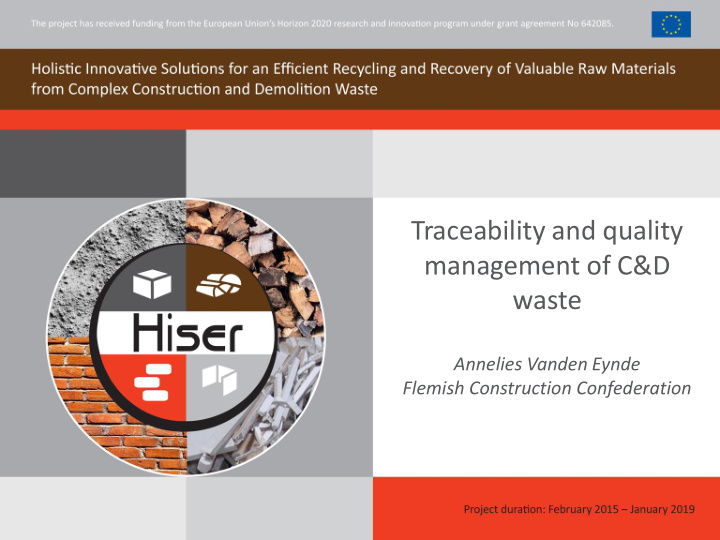



Traceability and quality management of C&D waste Annelies Vanden Eynde Flemish Construction Confederation
Belgium • 32.528 km² • Population: 11,2 mio • 3 Regions, 3 environmental legislations – Walloon Region – Flanders – Brussels Region • ± 13.900 km² C&D Waste • 7.3 mio inhabitants • > 15 mio tonnes/year C&D waste • High landfill taxes • > 90% recycled
Flanders: construction as a frontrunner in waste reuse
Circular economy – quality management CREATE MARKET ESTABLISH CONFIDENCE GOOD QUALITY OF RECYCLED MATERIAL End of waste criteria – reuse standards Traceability Independent control organisation Network of recycling facilities
Regulations for crushers (2011) • OVAM (Public Waste Agency of Flanders) Works out and implements policy on soil remediation and waste • End of waste criteria for recycled aggregates (Vlarema art. 2.3.2.1 en 2.3.2.2) • Regulations for crushers Improve the environmental quality of recycled granulates, there are inspections of external certication organisation. • Study 2012 12,8% non conformities (mostly in mixed aggregates) • 12,8% physical contamination (wood, glass, gypsum , …) • 6,6% asbestos contamination • 3,6% chemical contamination (Cu, B(a)pyrene, PCB, mineral oil)
Regulations for crushers (2011) • OVAM (Public Waste Agency of Flanders) Works out and implements policy on soil remediation and waste • End of waste criteria for recycled aggregates (Vlarema art. 2.3.2.1 en 2.3.2.2) • Regulations for crushers Improve the environmental quality of recycled granulates, there are inspections of external certication organisation. • Study 2012 12,8% non conformities (mostly in mixed aggregates) • 12,8% physical contamination (wood, glass, gypsum , …) • 6,6% asbestos contamination • 3,6% chemical contamination (Cu, B(a)pyrene, PCB, mineral oil) ACTION @ SITE OF ORIGIN: Selective demolition
Regulations for crushers (2016) Modification of regulations acceptance policy LMRP vs HMRP LMRP = low environmental risk profile. Risk of environmental contamination is low (physical, chemical, asbestos). This CDW can be processed in a continues process, the required control samples and rules are more limited (analysis is limited to critical parameters). HMRP = high environmental risk profile. Risk of environmental contamination is present (physical, chemical, asbestos). This CDW must be processed separately in flows of max 500m³ and all parameters need to be analysed. Cost for processing HMRP >>> Cost for processing LMRP Difference of 6 à 12 € /ton Modification of regulations which streams can be accepted as LMRP? C&D waste from selective demolition traced and followed up by an external demolition waste management organization
Tracimat Foundation of Tracimat – 1st Flemish C&D waste management organization – Founded in August 2014 – Recognized by the Flemish Government in August 2017 – Members: Construction Confederation, CASO, FPRG en ORI
Tracimat - certification of selective demolition Certificate of selective demolition tells the crusher whether the demolition waste can be accepted as “low environmental risk profile” ( LMRP ): Waste comes from selective demolition guarantee its origin (source) Based on a destructive predemolition inventory guarantee its quality (free of Control of correct removal of hazardous waste contaminants) Following a traceability system can be processed at a lower cost
Tracimat – Traceability & Quality management HOW to trace construction and demolition waste? Prior to demolition First step = inventory prior to demolition - inventory of hazardous and non-hazardous waste materials that will be released during demolition - information about: what is to be expected, quantity and location - ‘surprises’ during demolition works ↓↓ Inventory as a part of the tender for demolition works building owner is informed about hazardous waste in the building that is to be demolished cost - of (correct) removal must be taken into account - demolition contractor has a basis for price-setting: less speculation, less risk
Tracimat – Traceability & Quality management HOW to track construction and demolition waste? Selective demolition: decontamination, deconstruction/dismantling, demolition Follow-up of the removal of different waste streams – tracing materials - follow-up and tracking of removal of hazardous wastes as a priority - follow-up and tracking of other non-hazardous (non-stony) fractions - follow-up and tracking of stony fraction less hazardous waste materials end up in the environment more pure stony fraction is left quality can be assured
Tracimat – role? Quality Management • Quality check of pre-demolition inventory (waste audit) • Follow up of correct removal of hazardous waste • Traceability of waste set free during the demolition work improve quality of recycled materials - enhance trust and establish confidence – promote recycling & upcycling
Flowdiagram - tracing CDW contractor crusher expert tracimat PRIOR TO DEMOLITION START OF DEMOLITION notification Pre-demolition inventory and waste management plan Inspection visit & report Attestation of conformitiy demand Acceptance tender / Admission to LMRP LMRP offer Confirmation of demand acceptance Certificate of selective demolition
Tracimat – State of Play Tracing procedures approved by the Minister (3 February 2017) Tracimat becomes the first recognised CDW management organisation (in Flanders) – August 2017 Tra nsition period of 1 year mandatory low ERP/high ERP acceptance policy – 24 August 2018 Obligation for pre demolition audit (05/06/2018)
Tracimat - further developments • Cooperation with Recupel : responsible for collection Electronical waste – Link with our databank – Provide containers on site and take care of logistics and treatment (free of charge) • Cooperation with recycling companies / production plants – PVC – Limit transportation costs Develop Hubs – Gypsum? • Urban Mining – Data about materials in our cities, in our buildings – Important information to set up recycling plants and enhance recycling
Thank you Lombardstraat 34-42 B-1000 Brussels, Belgium Tel: (32) 2 545 58 60 www.tracimat.be Annelies Vanden Eynde Annelies.vandeneynde@tracimat.be
Recommend
More recommend